Onset of Convection in an Inclined Anisotropic Porous Layer with Internal Heat Generation
Abstract
:1. Introduction
2. Governing Equations and the Basic State
3. Linear Stability Analysis for Two-Dimensional Disturbances
3.1. Reduction to ODE Eigenvalue Form
3.2. Numerical Results
4. Linear Stability Analysis for Three-Dimensional Disturbances
4.1. Reduction to ODE Eigenvalue Form
4.2. Numerical Results
5. Conclusions
Author Contributions
Funding
Conflicts of Interest
Abbreviations
| c | phase velocity |
| g | gravitational acceleration |
| h | thickness of layer |
| k | wavenumber |
| longitudinal permeability | |
| transverse permeability | |
| p | pressure |
| q | rate of heat generation |
| Ra | Darcy-Rayleigh number |
| T | dimensional temperature |
| u | velocity in the x-direction |
| v | velocity in the y-direction |
| w | velocity in the z-direction |
| x | coordinate up the layer |
| y | coordinate across the layer |
| z | spanwise coordinate |
| Greek symbols | |
| inclination angle | |
| coefficient of thermal expansion | |
| nondimensional temperature | |
| thermal diffusivity | |
| growth rate | |
| dynamic viscosity | |
| anisotropy ratio | |
| density | |
| heat capacity ratio | |
| orientation of roll | |
| streamfunction | |
| Subscripts, superscripts, and other symbols | |
| * | dimensional |
| ′ | differentiation with respect to y |
| _ | amplitude |
| 0 | reference quantity |
| 1 | perturbation |
| b | steady basic flow |
| c | critical value |
References
- Horton, C.W.; Rogers, F.T. Convection currents in a porous medium. J. Appl. Phys. 1945, 16, 367–370. [Google Scholar] [CrossRef]
- Lapwood, E.R. Convection of a fluid in a porous medium. Proc. Camb. Philos. Soc. 1948, 44, 508–521. [Google Scholar] [CrossRef]
- Kulacki, F.A.; Ramchandani, R. Hydrodynamic instability in porous layer saturated with heat-generating fluid. Wärme-Stoffübertrag 1975, 8, 179–185. [Google Scholar] [CrossRef]
- Gasser, R.D.; Kazimi, M.S. Onset of convection in a porous medium with internal heat generation. ASME J. Heat Transf. 1976, 98, 49–54. [Google Scholar] [CrossRef]
- Buretta, R.J.; Berman, A.S. Convective heat transfer in a liquid saturated porous layer. ASME J. Appl. Mech. 1976, 43, 249–253. [Google Scholar] [CrossRef]
- Hardee, H.C.; Nilson, R.H. Natural convection in porous media with heat generation. Nucl. Sci. Eng. 1977, 63, 119–132. [Google Scholar] [CrossRef]
- Hwang, I.T.; Marr, W.W. Onset of thermal-convection in a fluid-saturated porous layer with heat source. Trans. Am. Nuclear Soc. 1977, 27, 655–656. [Google Scholar]
- Tveitereid, M. Thermal convection in a horizontal porous layer with internal heat sources. Int. J. Heat Mass Transf. 1977, 20, 1045–1050. [Google Scholar] [CrossRef]
- Rhee, S.J.; Dhir, V.K.; Catton, I. Natural convection heat transfer in beds of inductively heated particles. ASME J. Heat Transf. 1978, 100, 78–85. [Google Scholar] [CrossRef]
- Kulacki, F.A.; Freeman, R.G. A note on thermal convection in a saturated, heat generating porous layer. ASME J. Heat Transf. 1979, 101, 169–171. [Google Scholar] [CrossRef]
- Barletta, A.; Celli, M.; Nield, D.A. Unstable buoyant flow in an inclined porous layer with an internal heat source. Int. J. Therm. Sci. 2014, 79, 176–182. [Google Scholar] [CrossRef]
- Nandal, R.; Mahajan, A. Linear and nonlinear stability analysis of a Horton-Rogers-Lapwood problem with an internal heat sources and Brinkman effects. Transp. Porous Media 2017, 117, 261–280. [Google Scholar] [CrossRef]
- Nouri-Borujerdi, A.; Noghrehabadi, A.R.; Rees, D.A.S. Influence of Darcy number on the onset of convection in a porous layer with a uniform heat source. Int. J. Therm. Sci. 2008, 47, 1020–1025. [Google Scholar] [CrossRef]
- Nouri-Borujerdi, A.; Noghrehabadi, A.R.; Rees, D.A.S. The onset of convection in a horizontal porous layer with uniform heat generation using a thermal non-equilibrium model. Transp. Porous Media 2007, 69, 343–357. [Google Scholar] [CrossRef]
- Nield, D.A.; Kuznetsov, A.V. The onset of convection in a horizontal porous layer with spatially non-uniform internal heating. Transp. Porous Media 2016, 111, 541–553. [Google Scholar] [CrossRef]
- Nield, D.A.; Kuznetsov, A.V. Onset of convection in with internal heating in a weakly heterogeneous porous medium. Transp. Porous Media 2013, 98, 543–552. [Google Scholar] [CrossRef]
- Kuznetsov, A.V.; Nield, D.A. The effect of strong heterogeneity on the onset of convection induced by internal heating in a porous medium: A layered model. Transp. Porous Media 2013, 99, 85–100. [Google Scholar] [CrossRef]
- Matta, A.; Hill, A.A. Double-diffusive convection in an inclined porous layer with a concentration-based internal heat source. Contin. Mech. Thermodyn. 2018, 30, 165–173. [Google Scholar] [CrossRef]
- Mahajan, A.; Nandal, R. Stability of an anisotropic porous layer with internal heat source and Brinkman effects. Spec. Top. Rev. Porous Media 2019, 10, 65–87. [Google Scholar] [CrossRef]
- Yadav, D.; Wang, J.; Lee, J. Onset of Darcy-Brinkman convection in a rotating porous layer induced by purely internal heating. J. Porous Media 2017, 20, 691–706. [Google Scholar] [CrossRef]
- Malashetty, M.S.; Swamy, M.S. The onset of convection in a viscoelastic liquid saturated anisotropic porous layer. Transp. Porous Media 2007, 67, 203–218. [Google Scholar] [CrossRef]
- Yovogan, J.; Miwadinou, C.H.; Claude, E.V.; Degan, G. Effect of anisotropy in permeability on thermal convection of viscoelastic fluids in rotating porous layer heated from below. Aust. J. Mech. Eng. 2018. [Google Scholar] [CrossRef]
- Raghunatha, K.R.; Shivakumara, I.S.; Sowbhagya, A.A. Stability of buoyancy-driven convection in an Oldroyd-B fluid-saturated anisotropic porous layer. Appl. Math. Mech. 2018, 39, 653–666. [Google Scholar] [CrossRef]
- Abdelhafez, M.A.; Tsybulin, V.G. Modeling of anisotropic convection for the binary fluid in porous medium. Comput. Res. Model. 2018, 10, 801–816. [Google Scholar] [CrossRef]
- Yadav, D.; Kim, M.C. Theoretical and numerical analyses on the onset and growth of convective instabilities in a horizontal anisotropic porous medium. J. Porous Media 2014, 17, 1061–1074. [Google Scholar] [CrossRef]
- Rees, D.A.S.; Storesletten, L. The linear instability of a thermal boundary layer with suction in an anisotropic porous medium. Fluid Dyn. Res. 2002, 30, 155–168. [Google Scholar] [CrossRef]
- Rees, D.A.S.; Postelnicu, A. The onset of convection in an inclined anisotropic porous layer. Int. J. Heat Mass Transf. 2001, 44, 4127–4138. [Google Scholar] [CrossRef]
- Postelnicu, A.; Rees, D.A.S. The onset of convection in an anisotropic porous layer inclined at a small angle from the horizontal. Int. Commun. Heat Mass Transf. 2001, 28, 641–650. [Google Scholar] [CrossRef]
- Rees, D.A.S.; Storesletten, L.; Postelnicu, A. The onset of convection in an inclined anisotropic porous layer with oblique principle axes. Transp. Porous Media 2006, 62, 139–156. [Google Scholar] [CrossRef]
- Capone, F.; Gentile, M.; Hill, A.A. Penetrative convection via internal heating in anisotropic porous media. Mech. Res. Commun. 2010, 37, 441–444. [Google Scholar] [CrossRef]
- Rees, D.A.S.; Bassom, A.P. Onset of Darcy-Bénard convection in an inclined porous layer heated from below. Acta Mech. 2000, 144, 103–118. [Google Scholar] [CrossRef]
- Storesletten, L.; Tveitereid, M. Onset of convection in an inclined porous layer with anisotropic permeability. Appl. Mech. Eng. 1999, 4, 575–587. [Google Scholar]
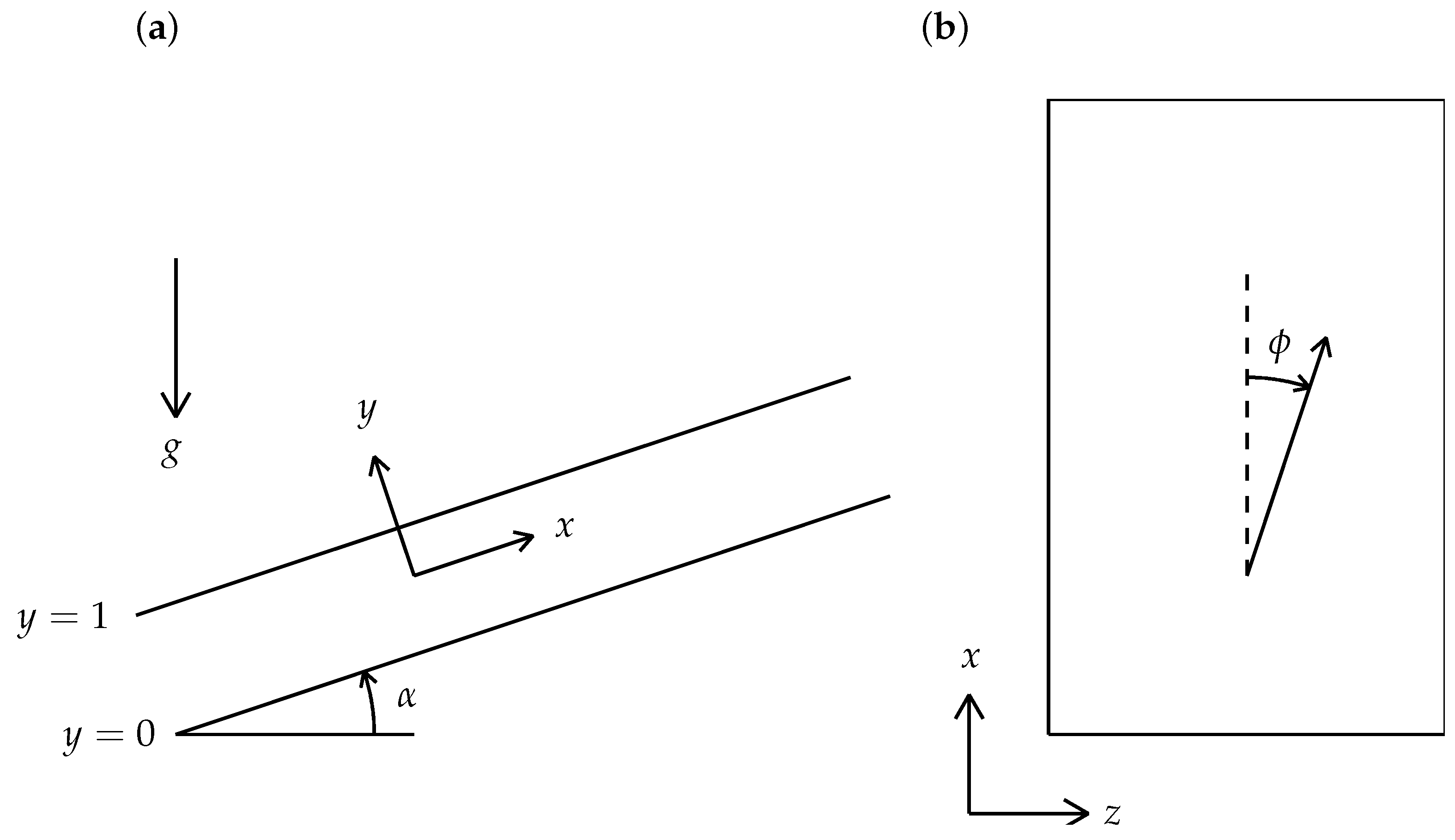
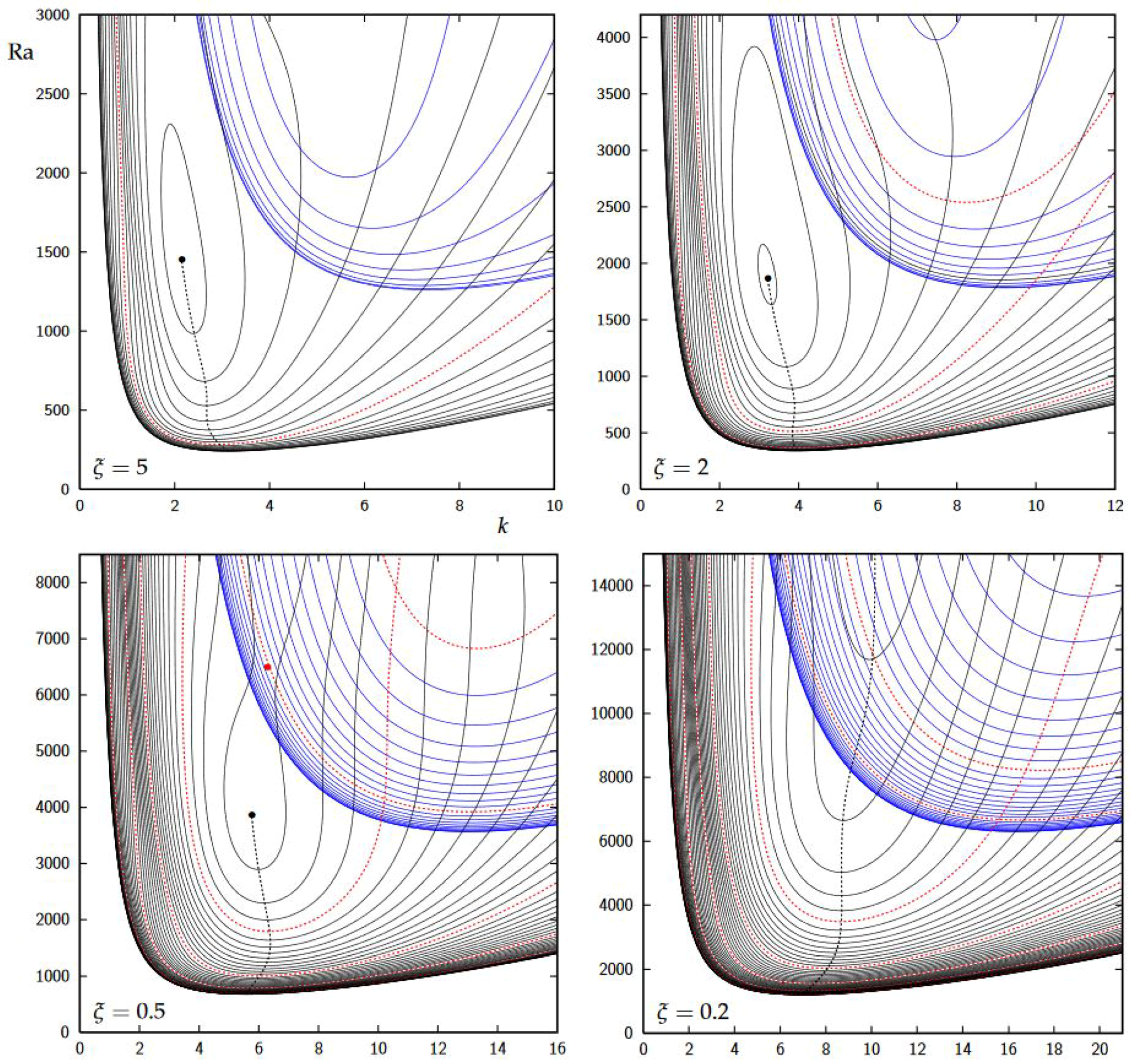

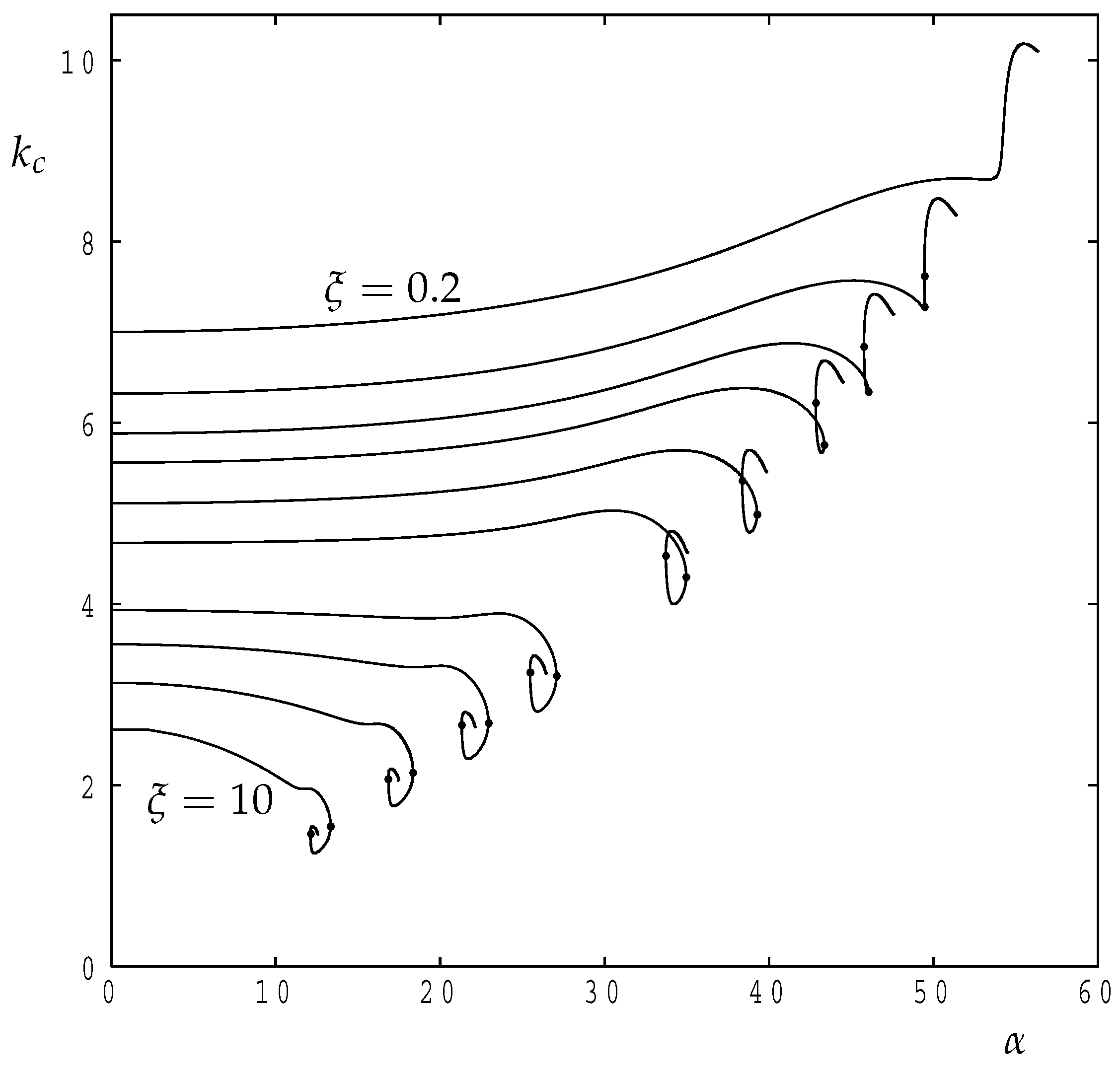
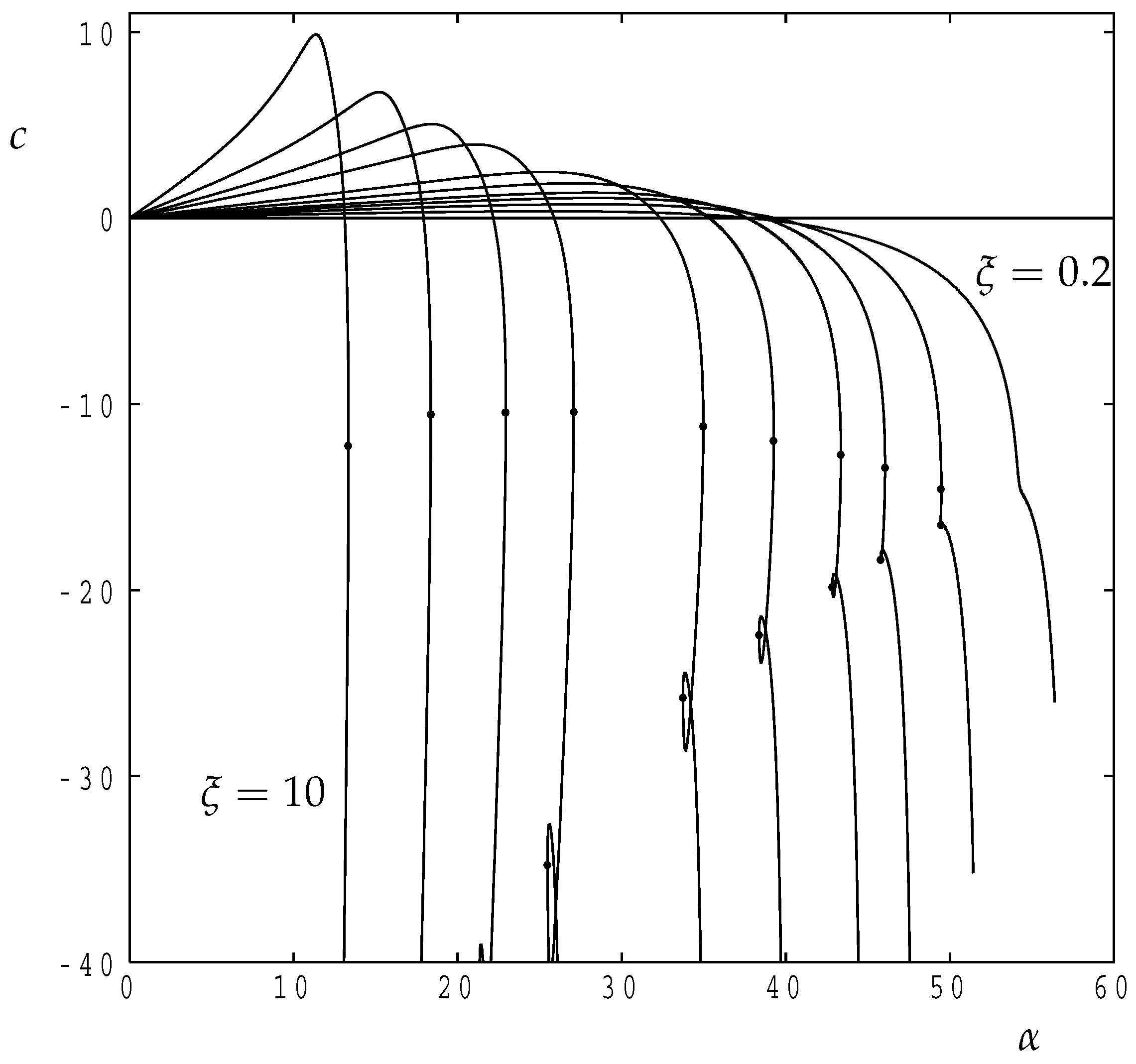

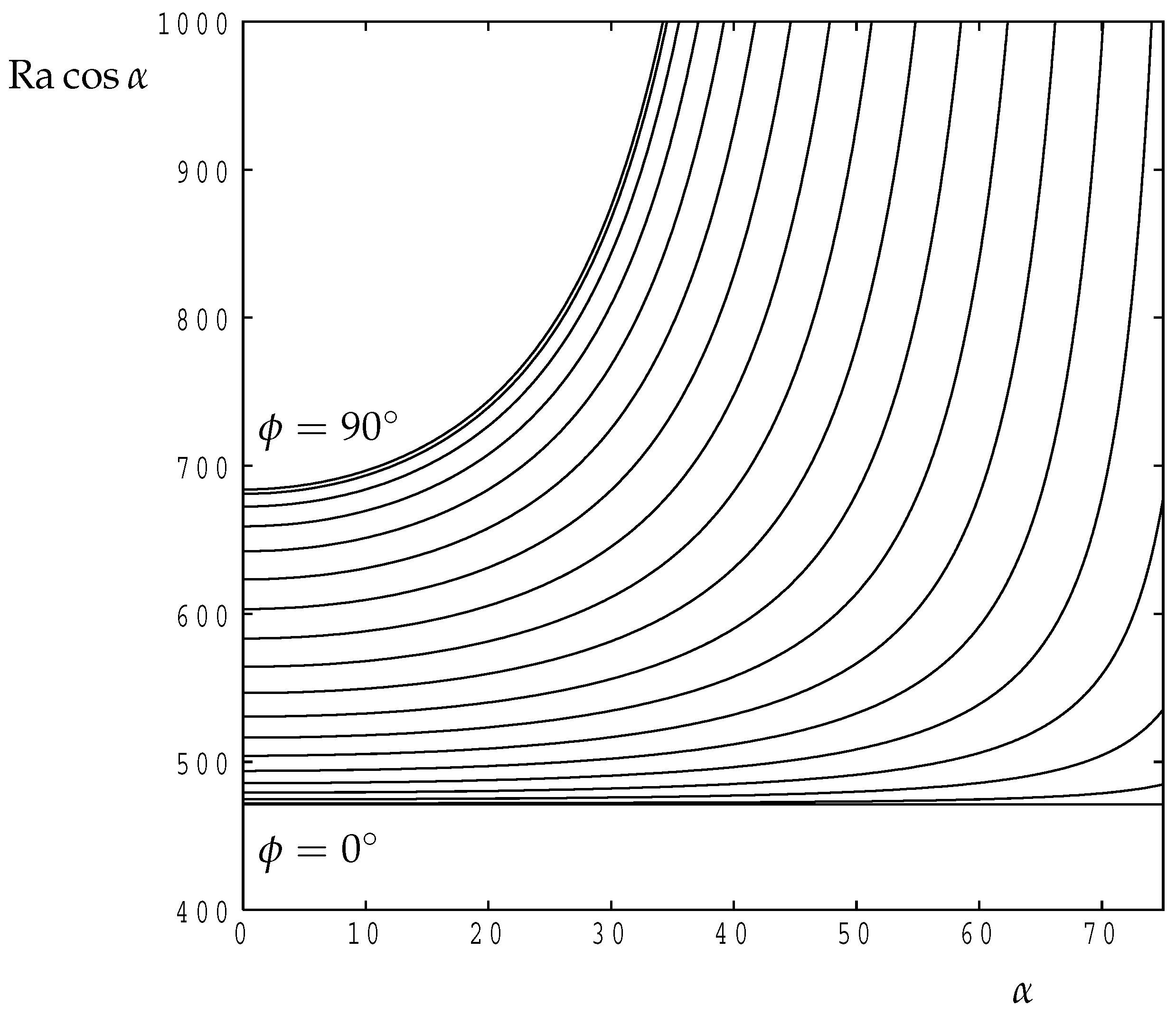
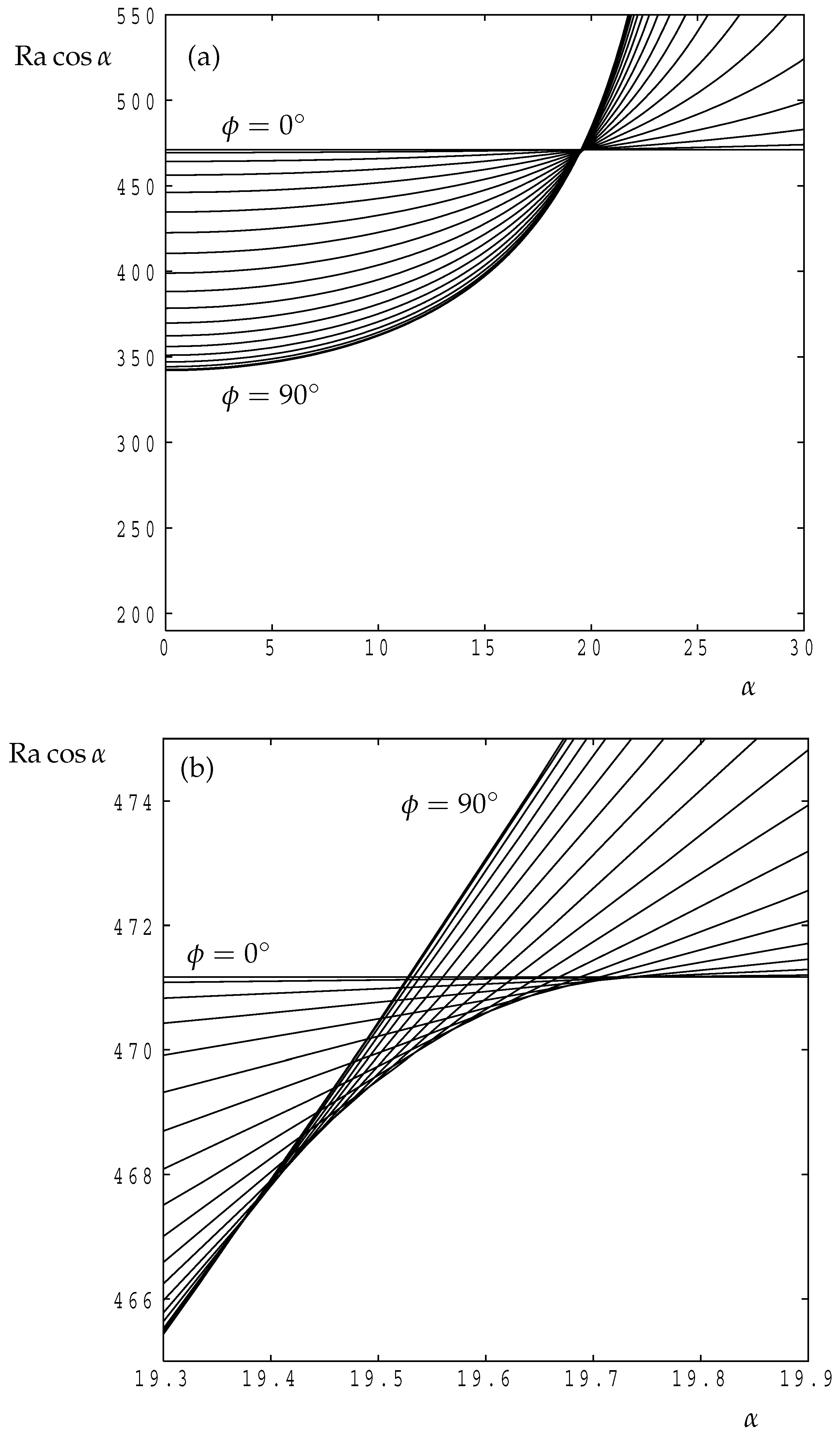
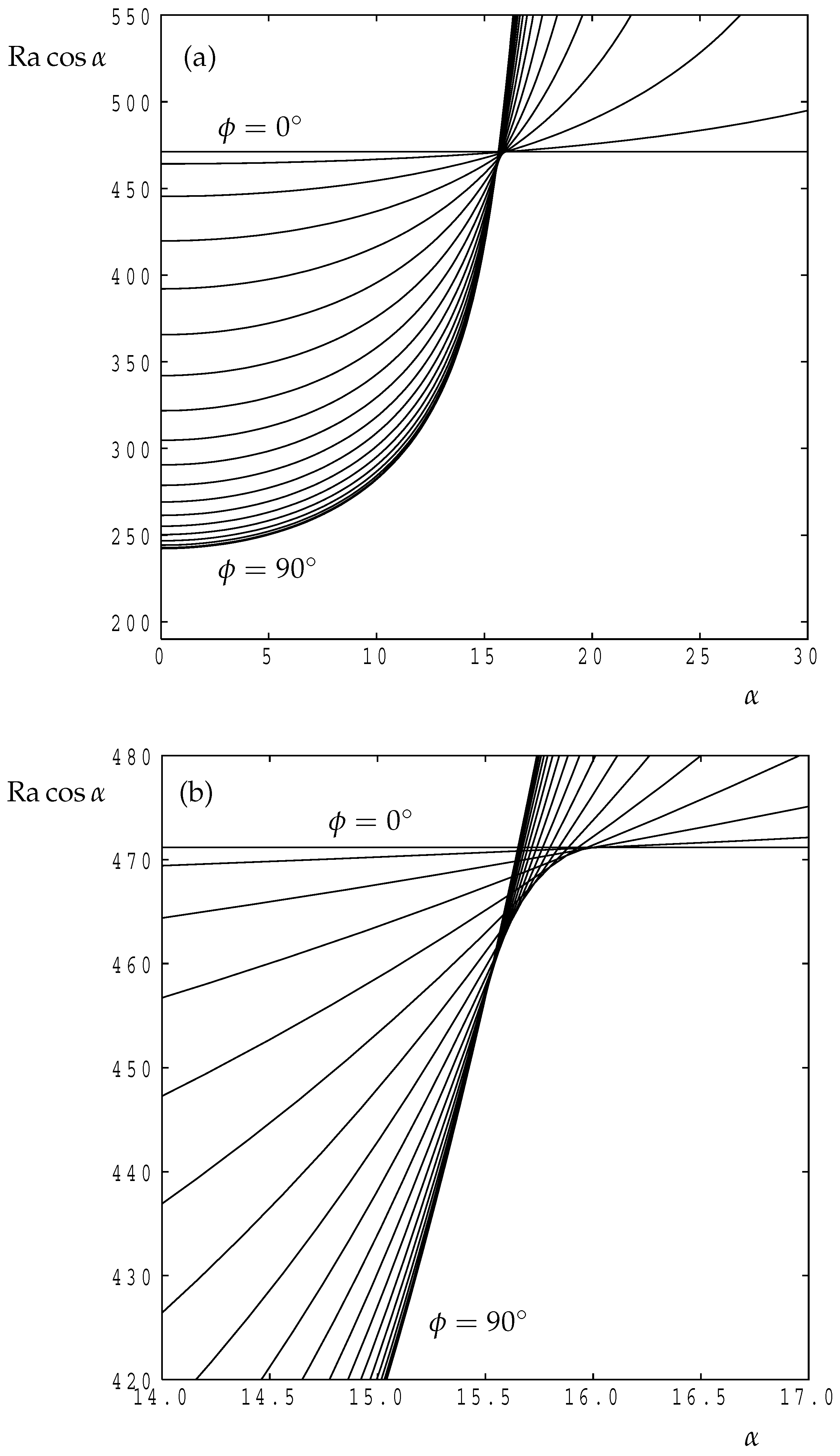

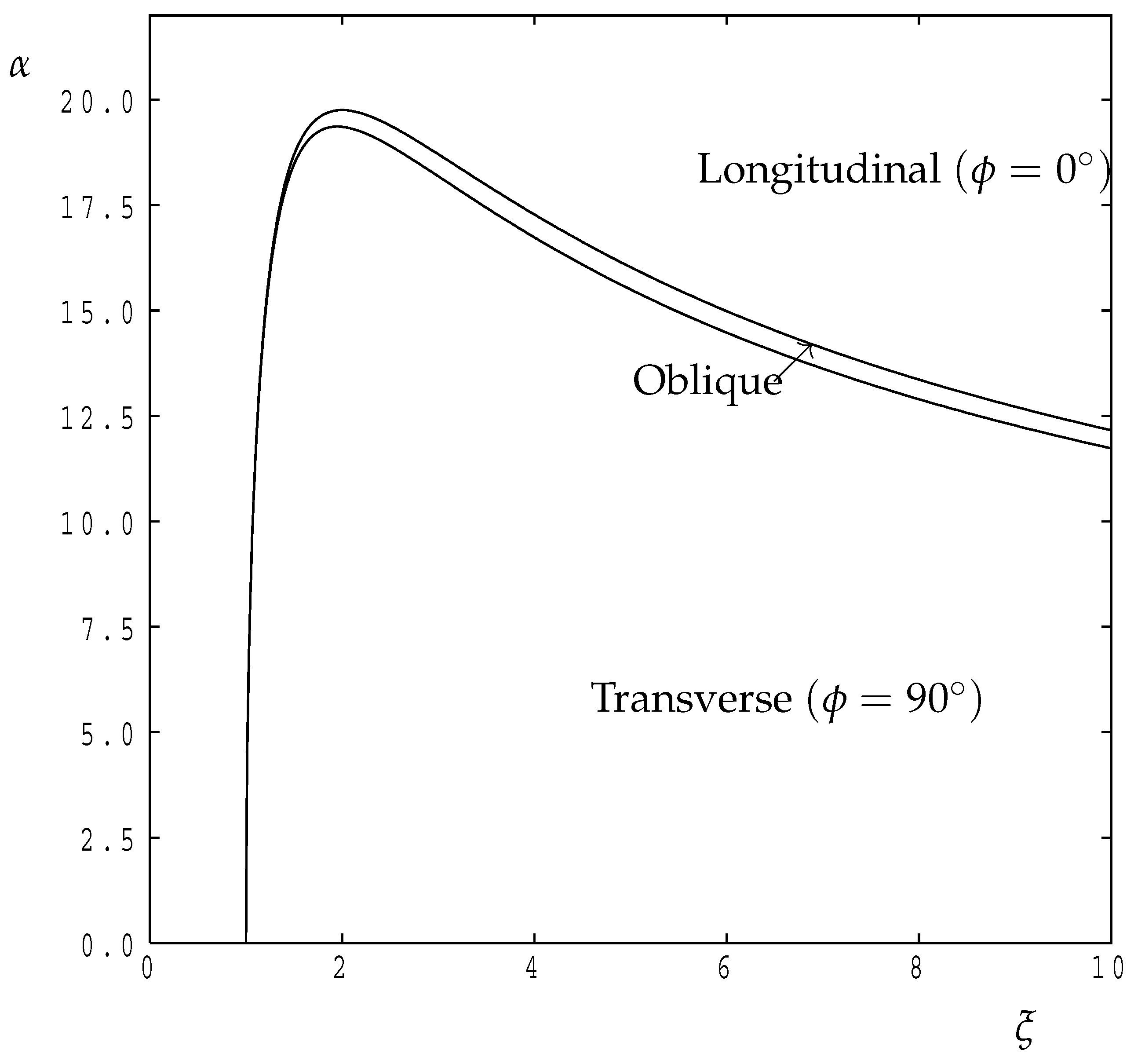
| for | for | |
|---|---|---|
| 125 | ||
| 250 | ||
| 500 | ||
| 1000 |
© 2019 by the authors. Licensee MDPI, Basel, Switzerland. This article is an open access article distributed under the terms and conditions of the Creative Commons Attribution (CC BY) license (http://creativecommons.org/licenses/by/4.0/).
Share and Cite
Storesletten, L.; Rees, D.A.S. Onset of Convection in an Inclined Anisotropic Porous Layer with Internal Heat Generation. Fluids 2019, 4, 75. https://doi.org/10.3390/fluids4020075
Storesletten L, Rees DAS. Onset of Convection in an Inclined Anisotropic Porous Layer with Internal Heat Generation. Fluids. 2019; 4(2):75. https://doi.org/10.3390/fluids4020075
Chicago/Turabian StyleStoresletten, Leiv, and D. Andrew S. Rees. 2019. "Onset of Convection in an Inclined Anisotropic Porous Layer with Internal Heat Generation" Fluids 4, no. 2: 75. https://doi.org/10.3390/fluids4020075
APA StyleStoresletten, L., & Rees, D. A. S. (2019). Onset of Convection in an Inclined Anisotropic Porous Layer with Internal Heat Generation. Fluids, 4(2), 75. https://doi.org/10.3390/fluids4020075






